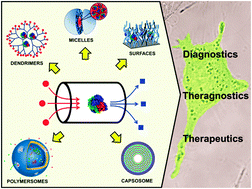Major challenges that confront nanoscience in medicine today include the development of efficacious therapies with minimum side effects, diagnostic methods featuring significantly higher sensitivities and selectivities, and personalized diagnostics and therapeutics for theragnostic approaches. With these goals in mind, combining biological molecules and synthetic carriers/templates, such as polymer supramolecular assemblies, represents a very promising strategy. In this critical review, we present protein–polymer systems as reaction spaces at the nano-scale in which the enzymatic reactions take place inside polymer supramolecular assembly, at its interface with the environment or in a combination of both. The location of the protein(s) with respect to the polymer assembly generates a diversity of systems ranging from nanoreactors to active enzymatic polymer surfaces. We describe these both in terms of general modelling and addressing the specific conditions and requirements related to the medical domain. We will particularly present protein–polymer nanoreactors that provide protected spaces for enzymatic reactions. We also show how polymer supramolecular structures, such as micelles, capsules, dendrimers and vesicles, can accommodate sensitive biomolecules to mimic natural systems and functions, and to serve as avenues for new medical approaches. Even though not yet on the market, we will emphasize possible applications of protein–polymer systems that generate reaction nanospaces—as novel ways to advanced medicine (264 references).

You have access to this article
 Please wait while we load your content...
Something went wrong. Try again?
Please wait while we load your content...
Something went wrong. Try again?


 Please wait while we load your content...
Please wait while we load your content...